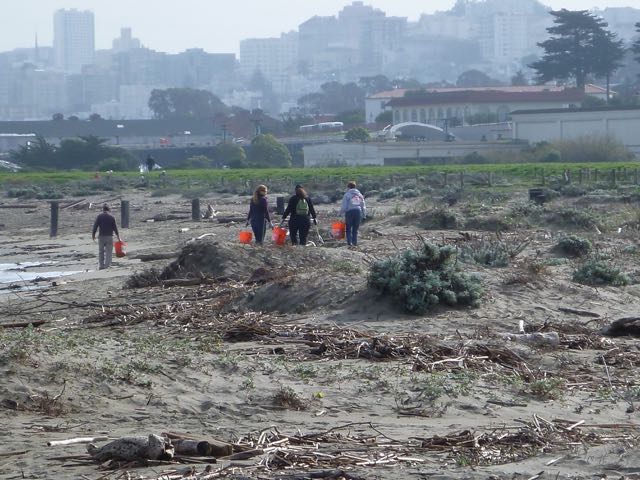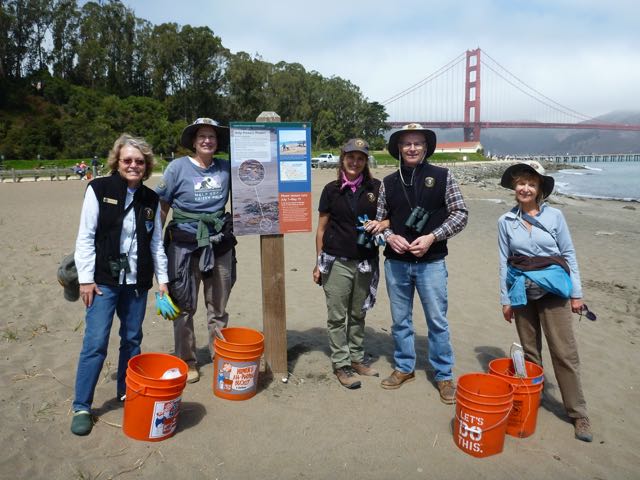Five years of Snowy Plover habitat help
By Corny Foster and Matthew Zlatunich
This March marks the fifth anniversary of Golden Gate Bird Alliance’s Snowy Plover Habitat Maintenance Program at Crissy Field. During monthly volunteer sessions, we’ve learned a lot about the habitat and avian residents at Crissy Field beach. We’ve also learned a lot – maybe more than we wanted – about the trash that shows up there.
To mark the fifth anniversary, here’s a history and progress report on this successful grassroots effort.
The Crissy Field Wildlife Protection Area — a favorite winter roosting site for threatened Western Snowy Plovers — is in the Presidio of San Francisco, and extends from Torpedo Wharf through the Crissy Beach West Dunes.
Before March, 2012, maintenance activities within the Crissy WPA were informal and irregular. They included efforts organized by the National Park Service and GGBA, as well as by individuals on their own, to collect trash, remove invasive weeds, plant native vegetation, and provide outreach/education to the public. But we knew a better job could be done.

In February, 2012, we worked with Laura Elze, Volunteer Coordinator for the Golden Gate National Recreation Area’s Facilities Management Division, to establish a monthly program aimed at stewardship of the Crissy WPA as suitable habitat for Snowy Plovers.
Objectives of the Snowy Plover Habitat Maintenance Program are to support the mission of the National Park Service, to support the U.S. Fish & Wildlife Service’s Western Snowy Plover Recovery Plan, to promote individual stewardship of natural resources, to engage people and build community around the ideals of ecological stewardship, and to help visitors see and appreciate a natural beach on the shoreline of San Francisco Bay.


Maintenance Mondays
Meeting on the second Monday of each month as a volunteer-driven program without the attendance of Park Service staff, we began our work in March, 2012. We remove debris and non-native vegetation, inspect signage and fences, and report needed repairs. We also monitor and document wildlife usage of the WPA. Regular participants are uniformly attired in Park-issued hats, vests, and nametags.
We use the SFSnowyPlovers Yahoo Group to communicate with interested parties, provide automated reminders of workdays, and to house documents and pictures related to the snowies and the program.
Since the WPA is small, we wanted to keep the head count at around six people per work day To do this, we list the volunteer opportunity at GGBA but not through the Park. GGBA also gets occasional inquiries from organized groups interested in volunteering, and coordinates with us to ensure suitability of size.
250 buckets of success
Our program has been very successful over the past five years, contributing over 700 volunteer hours, collecting over 250 buckets of trash and weeds, and providing the pleasure of birding while we worked!
We’re proud to say that the volume of trash as well as invasive non-native vegetation has been greatly reduced within the WPA due to our stewardship. But the trash keeps coming, as shifting dunes reveal hidden deposits and winter storms wash up all sorts of new debris.

Although we don’t keep records on individual trash items, we see high volumes of many of the same items over and over:
- Bits of Styrofoam.
- Bits of what appears to be insulation materials.
- Plastic small cigar tips.
- Plastic shotgun wadding.
- Cigarette filters.
- Plastic bottle caps.
- Many other recognizable plastic items including bottles, pens, lighters, cutlery, children’s toys and toy parts, etc.
- Many, many small unrecognizable plastic chips and nurdles.
The number of Snowy Plovers observed varies from month to month. Not surprisingly, we see the most snowies between October and March, their winter roosting season. Our highest count of 12 was seen just this last January! We’ve seen five banded plovers – with most frequent sightings of a bird identified as LW:YY, a regular at Crissy Field. Banded in 2007 at Crissy Field after the Cosco Busan oil spill, she’s been seen every year since we started the program.

We’ve also seen a wide variety of shorebirds, waterbirds, and passerines over the years. Every month is a new experience with a unique mix of wildlife using this sand dune habitat along the Bay shoreline. There’s always more trash to remove and more birds to spot… so if you’re interested in joining one of the best volunteer jobs in town, come on down to the Warming Hut in the Presidio on the second Monday of the month and help keep the world safe for Snowy Plovers!
To join a Crissy Field work day, meet at the Warming Hut, 983 Marine Drive in San Francisco, at 10 a.m. on the second Monday of the month. We ask participants to commit to at least six clean-up days each year. Find more information on this and other GGBA volunteer opportunities at goldengatebirdalliance.org/volunteer.
Retired from a career in banking, Corny Foster now spends her volunteer hours in the Presidio and on Alcatraz Island. In both locations, she works with birds and vegetation – resting Snowy Plovers and native habitat in the Presidio, and breeding waterbirds and historic gardens on Alcatraz. Corny was the winner of Golden Gate Audubon’s Elsie Roemer Conservation Award in 2016.
Matthew Zlatunich is a San Francisco firefighter and a lifelong naturalist. Matt has enjoyed volunteer work with Golden Gate Bird Alliance, the National Park Service, and other local environmental groups for many years. He has been monitoring and stewarding Snowy Plovers at Crissy Field since 2005. Matt was the winner of GGBA’s Elsie Roemer Conservation Award in 2008.
